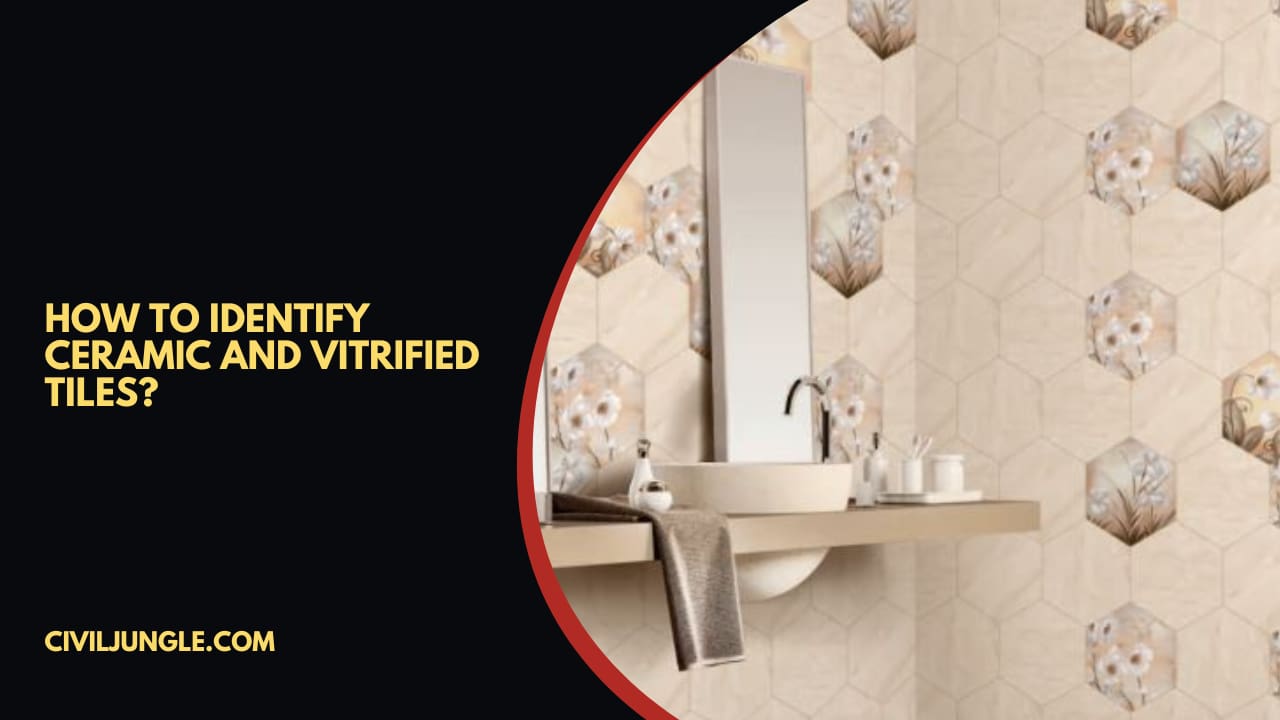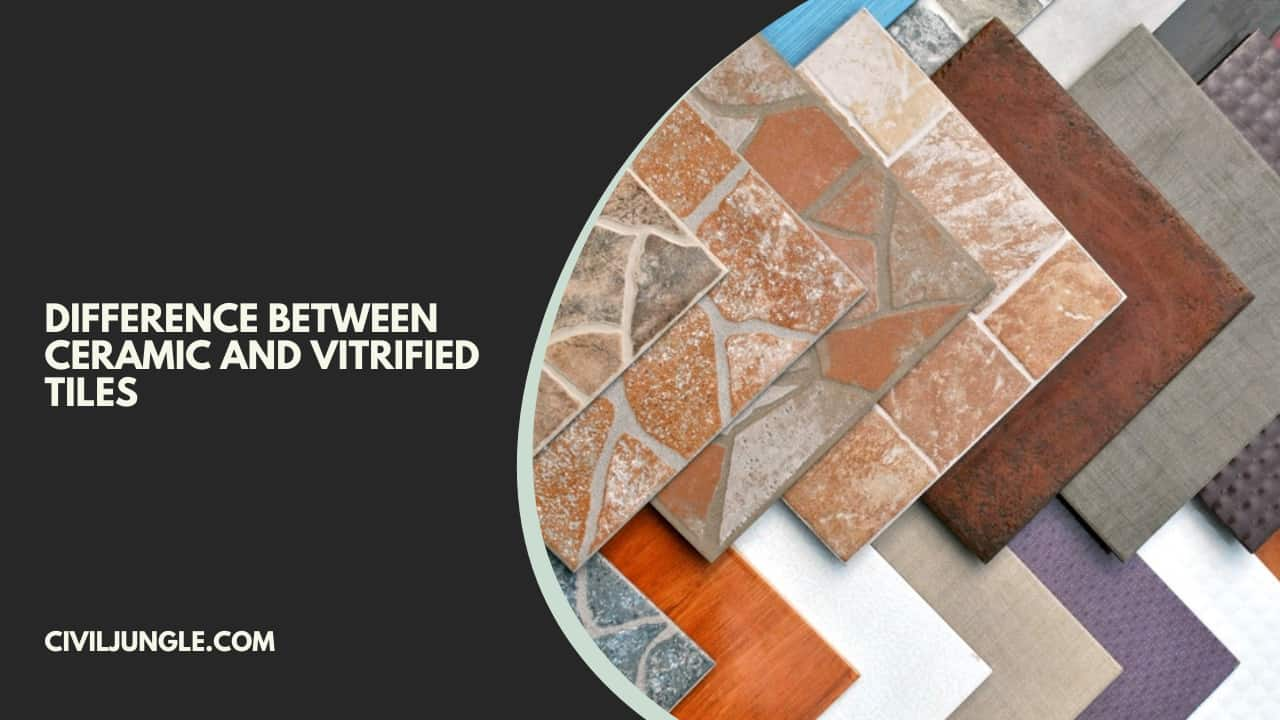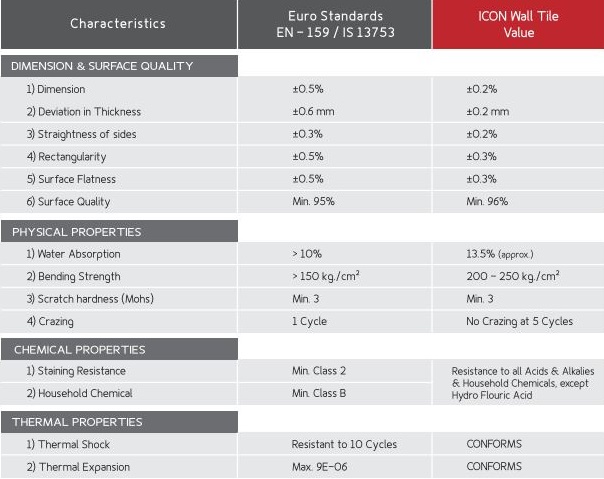What Is Vitrified Tiles?
Important Point
Vitrified tiles are very similar to ceramic tiles, but they are made with slightly different elements. The clay is mixed with quartz and feldspar before being heated in the oven.
These extra ingredients melt, creating a glass element within the tile. This glass component makes the vitrified files very hard and resistant to any type of absorption.
What Is Ceramic Tiles?
Ceramic tiles are made of natural clay that is mixed with water and molded. The creators apply an enamel on the tile to help protect it from water and scratches, then throw the clay in an oven to harden it.
Ceramic tiles can be supplied in a wide variety of colors and sizes, but they must always be vitrified for protection.
Also, read: What Is DLC (Dry Lean Concrete ) | Advantage of DLC (Dry Lean Concrete )
How to Identify Ceramic and Vitrified Tiles?
When setting up the home or office of your dreams, you will naturally leave the responsibility to design in the hands of professionals.
But it is always an advantage if you know a little about the trade. Not only can you get involved in the work in progress, but you can also make informed choices.
Most of the appearance is shared by the type of mosaic used. They accentuate the environment and reflect the natural brightness of the space.
It is important to make the right decision regarding blocks, based on the requirement and the purpose. Knowing your tiles and being able to differentiate between different varieties can make the job easier for you.
Also, read: M30 Grade of Concrete Mix Design Procedure with OPC 53 Cement
Difference Between Ceramic and Vitrified Tiles
| Sr.No. | Vitrified Tiles | Ceramic Tiles | |
| 1 | Definition | vitrified tiles are made of clay and a mixture of other minerals and solvents. | Ceramic tiles are made of clay and water baked at high temperatures in a kiln. |
| 2 | Forms | The vitrified tile has an absorption rate of 0.50%, almost frost-proof, while the ceramic tile varies from 7 to 3%, making it unsuitable for outdoor applications. | Inside, homeowners can use ceramics tiles and vitrified for the same applications, such as floors and countertops.
Outside, however, water becomes a very important factor in cold climates, since only a small amount of moisture can freeze in the winter months and break the tile. |
| 3 | Prices | Vitrified tiles cost a couple of dollars more per square meter because of their extra qualities. Vitrified tiles also need a stronger adhesive than ceramic tiles, which can cost more to install | The prices of ceramic tiles vary considerably, depending on the size and personalized work. They tend to cost between $ 8 and $ 20 dollars per square foot. |
| 4 | Glazing | Vitrified tiles need not be glazed. Shine can be given with mansion polish. | Ceramic tiles always glazed to be protection. |
| 5 | Installation | The installation of a vitrified tile is easy as compared to ceramic tiles. They do not require skilled labor. | The installation of ceramic tile is difficult as compared to vitrified tiles. Skilled labor is required. |
| 6 | Maintenance | The maintenance of vitrified tile is easy because of its shining surface it is easy to clean. | The maintenance of ceramic tile is not as easy as compared to vitrified tiles. |
| 7 | Look | Vitrified tiles have an artificial look as compare to the natural look of ceramic tiles. | Ceramic tiles have a natural and earthen look in comparison to the artificial look of vitrified tiles. |
| 8 | Colour Resistance to UV light | Vitrified tiles are very slippery as compared to ceramic tiles. Vitrified tiles are very slippery when wet. | Ceramic tiles – Direct exposure to sunlight will cause the colour of the tiles to be removed frequently and the tiles may fade for a period of time. |
| 9 | Resistance to Scratches | Vitrified tiles have more resistance to scratches so even when tiles have scratched the colour of the tiles will remain the same. | Ceramic tiles have a low resistance to scratches, so the colour of ceramic tiles do not remain the same throughout its surface over in period-of-time. |
| 10 | Nail Polishes | Instead of being vitrified, vitrified tiles are either polished or unpolished. Polished tiles have a shiny sheen, while unpolished versions are rougher and more natural-looking. | Unlike ceramic tiles, vitrified tiles are rarely vitrified. Instead, a dye is mixed with the clay before being burned. This dye makes the clay a uniform color; therefore, even if the vitrified tile is scratched, the color will remain the same. |
| 11 | Composition | The term vitrified means to convert into a glass-like substance, in this process of vitrification 40% clay and 60% silica is added. Vitrified tiles are made by a mixture of clay, silica, quartz, and feldspar which is a constituent-minerals in the granite rock. | Ceramic tile is made up of earthen clay and water. |
| 12 | Texture | Vitrified tiles are smooth and glossy. It will give you an aesthetic look and it is easy to clean. | The ceramic tiles are comparatively rough and the outer enamel is applied for the shiny appearance. |
| 13 | Durability | Vitrified tiles are more durable as compare to ceramic tiles due to their glass-like surface. | Ceramic tiles are less durable as compare to vitrified tiles. |
| 14 | Strength | Ceramic tiles are less strong than the vitrified tiles. Ceramic tiles have low flexural strength which is 20 N/mm2 and low breaking strength which is 200 N. | Vitrified tiles are stronger as compare to ceramic tiles. Vitrified tiles have high flexural strength of 35 N/mm2 and high breaking strength that is 700 N. |
| 15 | Size | Vitrified tiles
|
Ceramic tiles
|
| 16 | Water Absorption | Meanwhile, the vitrified tiles are not porous and therefore the water absorption is negligible. Therefore, it is more suitable for wet areas. | The tiles are very porous and therefore absorb water quickly. Therefore, the use of ceramic tiles in the external area will cause the tiles to develop cracks quickly. |
| 17 | Frost Resistance | Vitrified tiles have high frost resistance because of its water absorption is low as compared to ceramic tiles. | Ceramic tiles have low frost resistance hence these types of tiles absorb water quickly. |
| 18 | Staining Resistance | Vitrified tiles have high resistance to stain due to non-porosity, glossy finish, and also easy to clean. | Ceramic tiles have a low resistance to stains for example when oil falls on the surface of the ceramic tiles, it is difficult t remove to stain of the tile as compared to ceramic tiles due to the texture on top. |
| 19 | Slip Resistance | Vitrified tiles are very slippery as compared to ceramic tiles. Vitrified tiles are very slippery when wet.
|
Ceramic tiles are not as slippery as compared to vitrified tiles. Ceramic tiles can be treated to prevent slipping either by adding an adhesive |
Also, read: What is Plum Concrete | Application | Mix Design | Methodology
Main Differences Between Vitrified Tiles vs Ceramic Tiles:
Ceramic and vitrified tiles, both can be used on walls and floors. Both types of tiles are available in different varieties of colours, design patterns, and sizes.
Although they are used for the same purpose, there is a big difference between ceramic and vitrified tiles, that is, their properties, availability, cost, etc.
So here we try to provide a brief comparison between ceramic tiles and vitrified tiles, which will help you to make the right choice.
As mentioned earlier, the composition varies. The ceramics are made with clay, while the vitrified tiles contain a mixture of silica and clay.
Ceramic tiles have a thicker texture than vitrified tiles, known for their shiny appearance. However, ceramic tiles have a more natural and earthy appearance than vitrified tiles, whose glassy appearance gives an artificial touch.
The glazing process makes the vitrified tiles stronger than the tiles. As they are composed of a mixture of various materials, such as silica, quartz, and feldspar, together with clay, cooking at high temperatures melts them to make them more durable and resistant.
Due to their low porosity, vitrified tiles absorb very little water when compared to tiles. This makes vitrified tiles a good option for floors.
Vitrified tiles are more resistant to scratches and stains than ceramic tiles. Ceramic tiles are easier to install.
Finally, due to the obvious advantages of vitrified tiles, they cost more than ceramic tiles
Armed with these basic facts, you can easily distinguish the two types of pieces with just one look. You can also analyze which type of tile matches which purpose and install each according to its qualities.
Technical Specification of Tiles As Per IS Code: 13753 And Euro En-159
Vitrified Vs Ceramic Tiles
Ceramic tile is made up of earthen clay and water. Whereas the term vitrified means to convert into the glass-like substance, in this process of vitrification 40% clay and 60% silica is added. Vitrified tiles are made by a mixture of clay, silica, quartz and feldspar which is constituent minerals in the granite rock.
Vitrified Tiles Vs Ceramic Tiles: Price
Ceramic tile prices range considerably, depending on custom work and size. They tend to cost between $8 and $20 dollars per square foot. Vitrified tiles cost a couple of dollars more per square foot because of their extra qualities.
Difference Between Ceramic and Vitrified
Ceramics are made using earthen clay while vitrified tiles contain a mixture of silica and clay. Ceramic tiles have a coarser texture than vitrified tiles, which are known for their glossy look. Due to their low porosity, vitrified tiles absorb very little water when compared to ceramic tiles.
Ceramic Tiles Meaning
Ceramic tile is a type of tile that is typically made from red or white clay. Ceramic tile can be used in several areas throughout the house. Ceramic tile is made of clay that has been fired in a kiln. This means that it is not frost-proof, and it may chip or damage more easily than porcelain tile.
Vitrified Tiles and Ceramic Tiles
Ceramic tile is made up of earthen clay and water. Whereas the term vitrified means to convert into the glass-like substance, in this process of vitrification 40% clay and 60% silica is added. Vitrified tiles are made by a mixture of clay, silica, quartz and feldspar which is a constituent minerals in the granite rock.
How to Identify Ceramic and Vitrified Tiles?
Ceramic tiles have a coarser texture than vitrified tiles, which are known for their glossy look. However, ceramic tiles have a more natural and earthy look than vitrified tiles, whose glassy appearance gives an artificial touch. The process of vitrification makes vitrified tiles stronger than ceramic tiles.
Vitrified Tiles
Vitrified tiles are a mix of clay and silica. This fused material is heated at high temperatures which results in its unique texture. It appears shiny like a glass surface and is non-porous. Moreover, these tiles do not need extra glazing like ceramic tiles. Strong.
Vitrified Tiles Meaning
Vitrified tile is a ceramic tile with very low porosity. It is an alternative to marble and granite flooring. Vitrified tiles are often used outdoors due to their water and frost resistance. There are four types of Vitrified tiles Soluble salt, Double charge, Full Body, and Glazed.
Difference Between Ceramic and Vitrified Tiles
Ceramic tiles are made from clay, have higher porosity, and are less durable compared to vitrified tiles. Vitrified tiles are made from a mixture of clay and other materials, are highly durable, have low porosity, and are more expensive.
Ceramic Tiles Vs Vitrified Tiles
Porcelain tiles are ceramic tiles that have been baked beyond to improve thickness, and durability, and to render the tiles impermeable properties. Vitrified tiles are made by vitrifying the tiles, this gives them a glass appearance and creates an extremely uniform and sturdy substance.
Ceramic Tiles Price
Ceramic tiles cost, on average, between $2 and $20 per square foot. The cost to have the tiles professionally installed ranges between $5 and 20 per square foot, with a total cost ranging from $7 to $40 per square foot, including materials and labor.
What Is Vitrified Tiles?
Vitrified tile is a ceramic tile with very low porosity. It is an alternative to marble and granite flooring. Vitrified tiles are often used outdoors due to their water and frost resistance. There are four types of Vitrified tiles – Soluble salt, Double charge, Full Body, and Glazed.
Vitrified Floor Tiles
Vitrified floor tiles are a type of tile made from a mixture of clay, silica, quartz, and other additives. They undergo a process called vitrification, where they are fired at high temperatures to form a dense, non-porous material. Vitrified tiles are known for their durability, strength, and low water absorption. They are often used in high-traffic areas and are available in a wide range of designs, finishes, and sizes. Due to their superior properties, vitrified floor tiles are considered a premium option and are typically more expensive than ceramic or other types of tiles.
Ceramic and Vitrified Tiles Difference
Major differences between ceramic tiles and vitrified tiles:
Ceramics are made using earthen clay while vitrified tiles contain a mixture of silica and clay. Ceramic tiles have a coarser texture than vitrified tiles, which are known for their glossy look.
Vitrified Tiles Vs Ceramic Tiles Price
The material used to make vitrified tiles is silica, quartz, and feldspar. Ceramic tiles are less durable than vitrified tiles. Considering vitrified tiles vs ceramic tiles price, Ceramic tile is cheaper. Vitrified tiles are costlier compared to ceramic tiles due to their fine qualities.
Tiles Meaning
a thin rectangular slab of baked clay, concrete, or other material, used in overlapping rows for covering roofs.
Normal Tiles Price
In general, the tiles themselves typically cost between $2 to $10 per square foot , while the actual installation costs range from $5 to $14 per square foot. Four primary factors are going to influence how your tile installation will cost: Room size: Tile installation is priced per square foot.
What Are Vitrified Tiles?
Vitrified tiles are a type of ceramic tile that is created through a process called vitrification. Vitrification involves the conversion of materials into a glass-like substance by subjecting them to high temperatures. In the case of vitrified tiles, a mixture of clay, silica, quartz, and feldspar is fired at extremely high temperatures, typically exceeding 1200 degrees Celsius (2200 degrees Fahrenheit).
Vitrified Tiles or Ceramic Which Is Better?
Due to their low porosity, vitrified tiles absorb very little water when compared to ceramic tiles. This makes vitrified tiles a good choice for flooring. Vitrified tiles are more scratch and stain resistant than ceramic tiles.
Like this post? Share it with your friends!
Suggested Read-
- Tiles Vitrified
- Initial Setting Time of Ppc Cement
- Difference Between Lap Length and Development Length
- Tension Vs Compression | What Is Tension & Compression
- Difference Between Plasticizer And Superplasticizer in Civil
- Difference Between Plinth Level, Sill Level, and Lintel Level
- Difference Between One Way Slab and Two Way Slab | What is Slab
- Difference Between Timber And Wood | What is Wood | What is Timber
- Difference Between Beam and Column | What Is Beam | What Is Column
- Difference Between Bridge and Culvert | What Is Bridge | What Is Culvert
- Difference Between Flyover and Bridge | What Is Flyover | What Is Bridge
- Difference Between M Sand Vs River Sand | What is M-Sand & River Sand
- Difference Between Footing and Foundation | What is Footing and Foundation
- Difference Between OPC Vs PPC | What is Cement | OPC Cement | PPC Cement
- Difference Between Short Column and Long Column | What Is Column | Type of Column
- Difference Between Mortar and Concrete | What Is Mortar & Concrete | Type of Mortar &Concrete
- Difference Between Flexible Pavement and Rigid Pavement | What is Pavement | Type of Pavement
- Difference Between Pre-Tensioning and Post-Tensioning | What Is Prestressed | Methods of Prestress
Originally posted 2023-06-08 12:05:37.








Leave a Reply